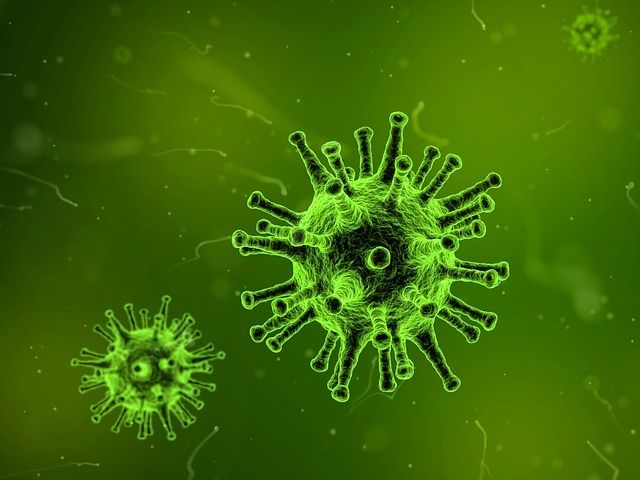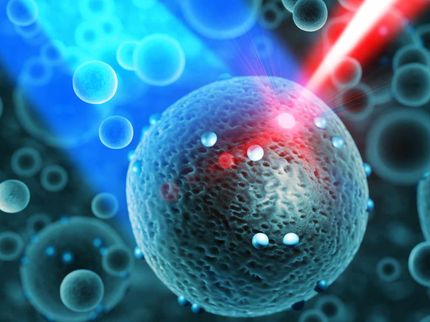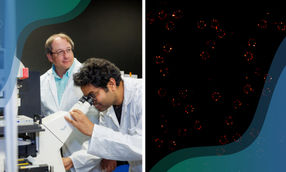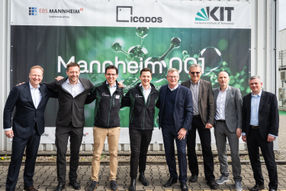Demonstration of large-scale technique to produce quantum dots
A method to produce significant amounts of semiconducting nanoparticles for light-emitting displays, sensors, solar panels and biomedical applications has gained momentum with a demonstration by researchers at the Department of Energy's Oak Ridge National Laboratory.
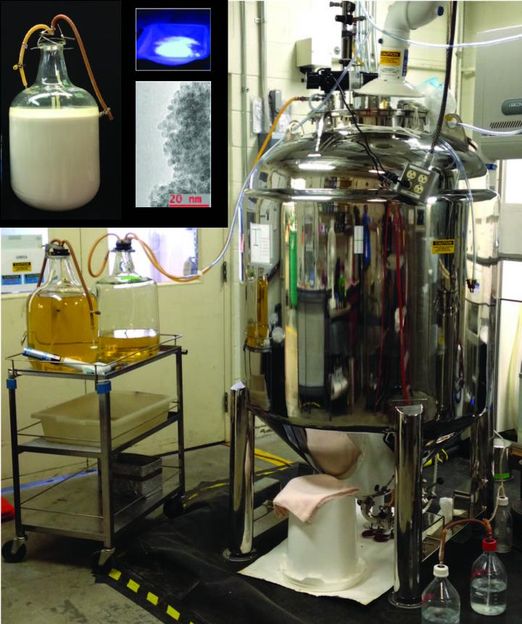
Using this 250-gallon reactor, ORNL researchers produced three-fourths of a pound of zinc sulfide quantum dots, shown in the inset.
ORNL
While zinc sulfide nanoparticles - a type of quantum dot that is a semiconductor - have many potential applications, high cost and limited availability have been obstacles to their widespread use. That could change, however, because of a scalable ORNL technique.
Unlike conventional inorganic approaches that use expensive precursors, toxic chemicals, high temperatures and high pressures, a team led by ORNL's Ji-Won Moon used bacteria fed by inexpensive sugar at a temperature of 150 degrees Fahrenheit in 25- and 250-gallon reactors. Ultimately, the team produced about three-fourths of a pound of zinc sulfide nanoparticles - without process optimization, leaving room for even higher yields.
The ORNL biomanufacturing technique is based on a platform technology that can also produce nanometer-size semiconducting materials as well as magnetic, photovoltaic, catalytic and phosphor materials. Unlike most biological synthesis technologies that occur inside the cell, ORNL's biomanufactured quantum dot synthesis occurs outside of the cells. As a result, the nanomaterials are produced as loose particles that are easy to separate through simple washing and centrifuging.
The results are encouraging, according to Moon, who also noted that the ORNL approach reduces production costs by approximately 90 percent compared to other methods.
"Since biomanufacturing can control the quantum dot diameter, it is possible to produce a wide range of specifically tuned semiconducting nanomaterials, making them attractive for a variety of applications that include electronics, displays, solar cells, computer memory, energy storage, printed electronics and bio-imaging," Moon said.
Successful biomanufacturing of light-emitting or semiconducting nanoparticles requires the ability to control material synthesis at the nanometer scale with sufficiently high reliability, reproducibility and yield to be cost effective. With the ORNL approach, Moon said that goal has been achieved.
Researchers envision their quantum dots being used initially in buffer layers of photovoltaic cells and other thin film-based devices that can benefit from their electro-optical properties as light-emitting materials.
Original publication
Ji-Won Moon, Tommy J. Phelps, Curtis L. Fitzgerald Jr., James G. Elkins, Gyoung Gug Jang, Pooran C. Joshi, Michelle Kidder, Beth L. Armstrong, Illia N. Ivanov, David E. Graham; "Manufacturing demonstration of microbially mediated zinc sulfide nanoparticles in pilot-plant scale reactors"; Applied Microbiology and Biotechnology; 2016
Most read news
Original publication
Ji-Won Moon, Tommy J. Phelps, Curtis L. Fitzgerald Jr., James G. Elkins, Gyoung Gug Jang, Pooran C. Joshi, Michelle Kidder, Beth L. Armstrong, Illia N. Ivanov, David E. Graham; "Manufacturing demonstration of microbially mediated zinc sulfide nanoparticles in pilot-plant scale reactors"; Applied Microbiology and Biotechnology; 2016
Organizations
Other news from the department science
These products might interest you
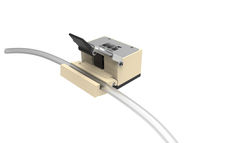
Hose pressure transducer by HiTec Zang
Contactless pressure measurement for sterile applications
Easy-to-install tubing pressure sensors for diameters from 4.8-19.1 mm

FireSting-PRO by PyroScience
New fiber optic measuring device: Precise measurements even in the smallest volumes
Measure pH, oxygen and temperature even under sterile conditions

Get the life science industry in your inbox
By submitting this form you agree that LUMITOS AG will send you the newsletter(s) selected above by email. Your data will not be passed on to third parties. Your data will be stored and processed in accordance with our data protection regulations. LUMITOS may contact you by email for the purpose of advertising or market and opinion surveys. You can revoke your consent at any time without giving reasons to LUMITOS AG, Ernst-Augustin-Str. 2, 12489 Berlin, Germany or by e-mail at revoke@lumitos.com with effect for the future. In addition, each email contains a link to unsubscribe from the corresponding newsletter.
Most read news
More news from our other portals
Last viewed contents
Buffer_P2
Electrophoretic_mobility_shift_assay
Forcible_retraction_of_the_foreskin
International_conference_on_bioinformatics
Familial_adenomatous_polyposis

A foreign language is transforming the brain - Learning a second language strengthens neural connections in the language network in the left hemisphere of the brain
Shedding light on protein interaction networks in a developing organism
Denver_Scale
Adrenal_tumor
House_Mouse
